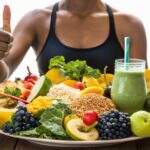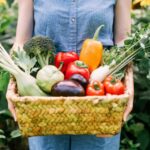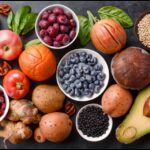The journey toward healthy living often involves considering what we put into our bodies. While you’ve likely heard of various diets that focus on plant-based eating, such as veganism, vegetarianism, and semi-vegetarianism, there’s another key player in this realm: the whole food plant-based (WFPB) diet. This concept, though increasingly popular, can be a source of confusion. So, let’s clear the air and explore the essential dos and don’ts of whole food plant-based eating.
Understanding Whole Food Plant-Based Eating
First, what exactly is a WFPB diet? Unlike diets that solely restrict animal products, a WFPB diet emphasizes the consumption of whole or minimally processed plants, including fruits, vegetables, grains, legumes, nuts, and seeds. It also involves steering clear of highly refined foods like added sugars, white flour, and processed oils.
The difference between this and other plant-based diets is subtle but significant. While vegetarian and vegan diets might allow processed foods and sugars, provided they don’t contain animal products, a WFPB diet strictly promotes foods in their most natural state, maximizing nutritional benefits and minimizing unhealthy additives.
The Benefits of Whole Food Plant-Based Diets
Why opt for a WFPB diet? The benefits are manifold. From a health perspective, this diet is a powerhouse. It’s linked to a host of health perks, including lower cholesterol and blood pressure levels, improved blood sugar stability, decreased inflammation, and a lower risk of chronic diseases such as diabetes, heart diseases, and certain cancers. Additionally, because this diet is high in fiber and essential nutrients but low in calories, it can also be an effective strategy for weight management.
Environmental benefits are also on the table. A WFPB diet requires fewer resources like land, water, and energy, contributing to reduced greenhouse gas emissions and deforestation, hence promoting a more sustainable and responsible way of living.
Dos of Whole Food Plant-Based Eating
Navigating a new diet can be daunting, so here’s what you should focus on:
Incorporate a Variety of Fruits and Vegetables:
From leafy greens to vibrant berries, fruits and vegetables should be your dietary staples. They’re not just vitamin and mineral goldmines; they’re also packed with essential phytochemicals and antioxidants.
Choose Whole Grains
Swap refined grains for whole ones. Think brown rice, millet, barley, and whole wheat. These are nutrient-dense, high in fiber, and they help maintain a healthy digestive system.
Include Legumes and Beans
These are fantastic protein sources and also provide other vital nutrients like iron, calcium, and fiber.
Add Nuts and Seeds
Though they should be consumed in moderation due to high caloric density, nuts and seeds are rich in healthy fats, protein, and various vitamins and minerals.
Don’ts of Whole Food Plant-Based Eating
While incorporating beneficial foods, you should also be mindful of what to avoid:
Avoid Animal Products
This includes all meats, dairy, and eggs. Animal products are often high in saturated fats and can contain harmful hormones and antibiotics.
Say No to Highly Processed Foods
These are not just limited to junk food. Many products might appear healthy at first glance but are actually packed with added sugars, unhealthy fats, and high levels of sodium.
Beware of Processed Plant-Based Foods
Not all plant-based foods are created equal. Some contain heavily processed ingredients or excessive additives. Always read labels carefully!
Understanding Processed vs. Minimally Processed Foods
When we say “minimally processed,” we’re talking about foods that have been slightly altered for preservation but still retain most of their nutritional value. Think cut vegetables, roasted nuts, or frozen fruits. Heavily processed foods, on the other hand, have been significantly modified from their natural state and are often laden with additives, preservatives, and other chemicals. These are the ones to avoid on a WFPB diet.
How To Make Plant-Based Food Healthier?
Challenges and Solutions in Whole Food Plant-Based Eating
Of course, embarking on this journey isn’t without its challenges. There’s the issue of accessibility, the potential cost of fresh, organic produce, and the time and knowledge needed for meal planning and preparation. However, these hurdles are not insurmountable. With a bit of planning, perhaps growing some of your own produce, and allocating time each week to prepare meals, you can certainly make this lifestyle work for you.
The whole food plant-based diet isn’t just another trend; it’s a lifestyle change that offers profound benefits for your health and the planet. By embracing the dos and avoiding the don’ts, you’re not just nourishing your body; you’re also contributing to a more sustainable and humane world. Are you ready to make a change that benefits your health and the environment?
FAQs
Is it expensive to follow a whole food plant-based diet?
Not necessarily! Buying whole foods like grains, legumes, and seasonal vegetables can be cost-effective, especially when purchased in bulk.
Can I get enough protein on a WFPB diet?
Absolutely. Foods like legumes, beans, nuts, seeds, and whole grains are excellent sources of plant-based protein.
Will I need supplements on a WFPB diet?
You might need certain supplements like B12, which is naturally found in animal products. However, it’s best to consult with a healthcare provider for personalized advice.
Can I eat out on a WFPB diet?
Yes, though it might require more planning and asking about meal ingredients and preparation.
Is a WFPB diet suitable for children and pregnant women?
With careful planning to ensure nutrient intake, it can be. However, it’s always important to consult a healthcare professional when dietary changes affect vulnerable populations.







